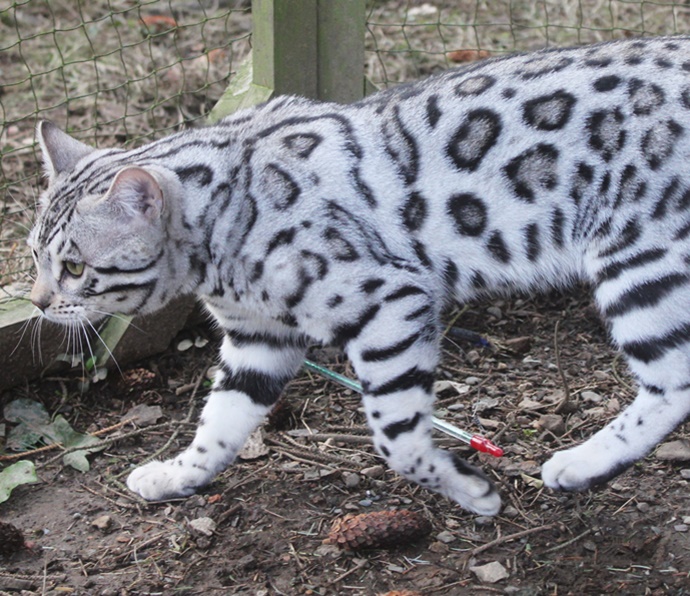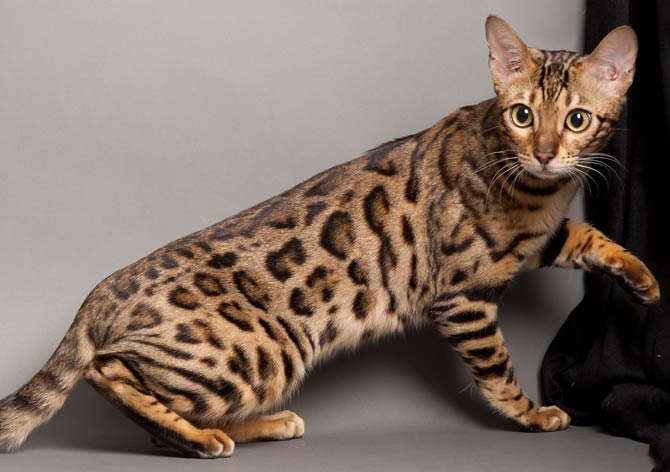Table Of Content

Families with large houses and responsible and active children who can engage with the cats can absolutely love a Bengal Cat. Inexperienced cat owners, people with small living accommodations, and families with small children might find Bengal Cats overwhelming. Bengal Cats can be willful, and they can scare or hurt small children who do not handle them properly. If you have never owned cats before, you will likely want to avoid Bengal Cats as your first option. Bengal Cats are an American cat breed that mixes native domestic shorthair breeds with the Asian Leopard Cat.
Behavior and Training Tips for Bengals
Bengal cat coats are less wild than they look, genetic study finds - Stanford Medical Center Report
Bengal cat coats are less wild than they look, genetic study finds.
Posted: Mon, 25 Mar 2024 07:00:00 GMT [source]
This blue base coat will have dark gray-blue patterns of spots or marble. While some states ban the ownership of early generations of Bengal cats, many states allow ownership of fifth generation and beyond. F5 generation can be owned legally in every state in America other than Hawaii.
Bengal Cat History
Why Are Bengal Cats Illegal? The Controversial Breed Explained - Green Matters
Why Are Bengal Cats Illegal? The Controversial Breed Explained.
Posted: Mon, 02 Oct 2023 07:00:00 GMT [source]
Overall look of head is often distinct from the domestic cat. Muzzle full and broad, with large, prominent whisker pads and high, pronounced cheekbones. If you're truly made of steel, you may not have reacted at all, but for most people, it's impossible not to flare your nostrils at least. All of these reactions are perfectly natural, though humans aren't the only species that reacts to smells, both good and bad.

The Remarkable Russian Blue: Comparing Olga to the Breed Standard
In that way, Bengal cats are similar to cats that are bred with North American bobcats. Because Bengals are a cross between a wild exotic cat and a domestic cat, some U.S. states and cities may not allow them as house pets. These cats are prohibited as residential pets in New York City and in the state of Hawaii, while other cities like Seattle and Denver have their own limits. The exotic-looking Bengal, like most cats, needs a balanced, high-protein, meat-centric healthy diet to thrive. In general, when it comes to cat foods, canned food tends to have more protein than dry alternatives.
By paying attention to these key features and behaviors, you can easily distinguish between different cat breeds. Remember, practice makes perfect, so don’t be discouraged if you can’t identify a breed right away. With time and experience, you’ll become a pro at spotting the differences. Bengal cats are generally larger and heavier than most house cats. A mature Bengal cat can weigh between 10 to 15 pounds, while house cats typically weigh between 8 to 10 pounds.
Similar Breeds
You should be able to see the mother of the kittens interacting with them, and she should have the classic temperament of a Bengal cat. They will be in great condition, have a purpose beyond parenting kittens and have had all the relevant health tests carried out. Some will live longer than others, and picking a kitten from DNA tested health cleared parents will increase your chances of your cat living longer. Therefore the best course of action is to avoid any breeders who raise red flags when discussing their medical history. Ideally the breeder will have had her breeding parents x-rayed and their hips confirmed as in good condition. PRA is an inherited disease which causes blindness, and is common to many pedigree breeds.
A home without any other smaller pets will be the best fit for a Bengal. It’s important that you understand your cat’s hunting instincts, and you can work to satisfy them through play. When you own a Bengal, your house will definitely become your cat’s territory, and your decorating will probably change, too.

When a male and female Bengal each carry a copy of the recessive long hair gene, and those two Bengals are mated with each other, they can produce long-haired Bengals. A Bengal cat is a pedigree breed, created by mixing Asian Leopard cats with domestic cats. A small percentage of Bengal cats develop a form of enlarged heart called hypertrophic cardiomyopathy (HCM). Just like their wild cousins, Bengal cats need a diet that focuses on meat, particularly if they are members of the first three generations. Most commercial kibble is not really suitable for Bengals, as it is too high in carbohydrates. High-quality canned, fresh or raw food is a good choice as it generally has a higher meat content.
Climbing and exploring their surroundings are second nature to them, so don’t be surprised if you find them perched on top of your bookshelf or chasing shadows on the wall. Now, I won’t lie to you – Bengals can be a bit mischievous at times. But with proper training and attention, they can adapt well to indoor living. Just like humans, they need mental challenges to keep their active minds occupied. Engage them with puzzle toys or teach them new tricks – they’ll love the mental workout.
Bengals learn very quickly, and enjoy learning new behaviors. In fact, they may learn tricks you’d rather they didn’t, such as turning on and off light switches, opening doors, and flushing toilets. The curious Bengal may get into everything, and changes in the home often provoke a quick response from the Bengal. Open a cupboard and your Bengal may dive in for a look-see, and will rearrange the contents if they’re not up to his standards.
Not all Bengals have a higher-than-average prey drive, but owners should make sure to keep fish tanks, rodents, reptiles, and bird habitats closed securely. These kitties may be domestic, but they are skilled hunters and crave the chase. You want your Bengal to be happy and healthy so you can enjoy your time with him, so do your homework before you bring him home. Bengals have hereditary health issues that can be a concern, especially if you aren’t cautious about who you buy from.
Bengal cats are prone to this disease, but there is a DNA test available. This will mean you can be confident that your Bengal cat will not develop signs of PRA later in life. This will reduce the chance of your kitten suffering from it later in life. This will help to reduce the amount that they shed and promote the quality of the coat.
An F2 Bengal is second generation, F3 is third generation, F4 is fourth, and so on. Bengals are often happy to walk on a leash, as they have a built-in need to explore. If you adopt a Bengal kitten, teach them how to walk on a harness and leash from a young age if you’d like to enjoy this activity together. Safe outdoor exploration offers the ideal opportunity for exercise and stimulates your cat's inquisitive mind.
Good breeders will have just a few cats living in their home with them. If you decide that a Bengal kitten is the best choice for your family, then your first step will be to find a reputable breeder. Like many pedigree breeds, Bengal cats do have a number of potential health problems to contend with.

No comments:
Post a Comment